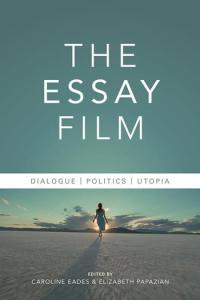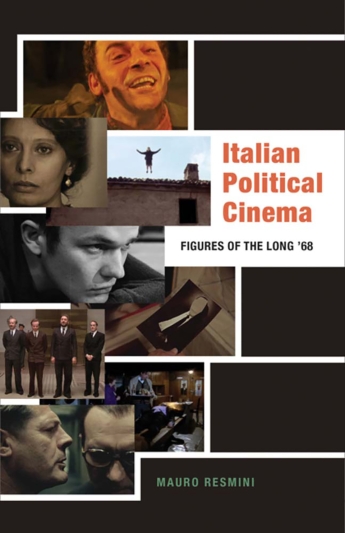Mauro Resmini

School of Languages, Literatures, and Cultures
Associate Professor, Italian
Associate Professor, Cinema and Media Studies
4104 Jiménez Hall
Get Directions
Education
Ph.D., Italian Studies and Modern Culture and Media, Brown University
Research Expertise
Critical Theory
Film studies
Media Studies
Philosophy
Mauro Resmini is Associate Professor of Cinema and Media Studies and Italian at the University of Maryland, College Park, where he is also core faculty in Comparative Literature. His research centers on the relationship between cinema and politics, with a focus on postwar Italian cinema and a theoretical framework informed by critical theory, philosophy, and psychoanalysis. He is the author of Italian Political Cinema: Figures of the Long '68 (University of Minnesota Press, 2022) and Steven Spielberg (Il Castoro, 2014). His essays appeared in American Imago, Camera Obscura, The Italianist, Diacritics, Journal of Italian Cinema and Media Studies, and several edited volumes. He is a contributing editor of Discourse: Journal for Theoretical Studies of Media and Culture (Wayne State University Press). In 2024-25, he served as the Clara and Robert Vambery Distinguished Professor of Comparative Studies. Since 2022, he has been one of the lead organizers of Il Cinema Ritrovato on Tour at UMD, an international festival of restored films in partnership with the National Gallery of Art and the American Film Institute. Prof. Resmini is currently working on a monograph on the representation of resentment in cinema.
Books
Italian Political Cinema: Figures of the Long '68 (University of Minnesota Press, 2023) - Available open access on Manifold
Steven Spielberg (Editrice Il Castoro, 2014) (in Italian)
Articles
- "The Right to a Past: Amelio and Bertolucci with Fortini," Journal of Italian Cinema and Media Studies, Volume 13, Issue 4 (2025).
- "Capitale e risentimento: Il petroliere di Paul Thomas Anderson,” in Historytelling/1. Forme, sguardi e metodi della Storia nel cinema contemporaneo (2000-2023), Maria Francesca Piredda et al., eds. (Milan: Mimesis, 2025) (in Italian).
- “Periodizing Drama: Appunti su The Deuce,” in La grande Storia e il piccolo schermo, Andrea Bellavita, ed. (Milan: Mimesis, 2022) (in Italian).
- “The Worker as Figure: On Elio Petri’s The Working Class Goes to Heaven,” Diacritics Vol. 46, No. 4 (2019).
- “Asymmetries of Desire: Salò or the 120 Days of Sodom,” in The Unwatchable, Maggie Hennefeld et al., eds. (New Brunswick: Rutgers University Press, 2019).
- “Obscurity, Anthologized: Non-Relation and Enjoyment in Love and Anger (1969),” in 1968 and Global Cinema, Christina Gerhardt and Sara Saljoughi, eds. (Detroit: Wayne State University Press, 2018).
- “‘What Does It Mean to Be a Communist Today?’ Nanni Moretti’s Palombella rossa and La cosa as Essay Films,” in The Essay Film: Dialogue, Politics, Utopia, Caroline Eades and Elizabeth Papazian, eds. (New York: Wallflower – Columbia University Press, 2016).
- “‘Il Senso dell’intreccio’: History, Totality, and Collective Agency in Romanzo Criminale,’ The Italianist Vol. 36, No. 2 (Fall 2016).
- “Re-Framing the New French Extremity: Cinema, Theory, Mediation,” Camera Obscura: Feminism, Culture, and Media Studies 90, Vol. 30, No. 3 (December 2015), 161-187.
- “The Italian Turn. A Certain Tendency in Contemporary Psychoanalytic Aesthetics,” American Imago 70, No. 2 (Summer 2013), 271-297.
Teaching
- ITAL436/CINE441 Italian Cinema I
- ITAL473/CINE431 Italian Cinema II
- ITAL499J/CINE429J Terrorism and Political Violence in Italy
- CINE245 Film Form and Culture
- FILM302 History of Cinema II: The Sound Era
- FILM319D The Geopolitics of Contemporary Storytelling
- CINE329R The Mafia: From Corleone to Hollywood
- FILM369A Post-war Film Theory
- CMLT679I/FREN699C/GERM689C/SLLC698C Comparative Media Studies
- CINE319C Images of Revolt: Riot, Strike, Uprising
Publications
Form as Critique: On Fire at Sea
Explore the deeper ethical dimensions of Fire at Sea through this thought-provoking analysis.
Author/Lead: Mauro ResminiIn Gianfranco Rosi’s 2016 film Fire at Sea, the haunting duality of Lampedusa—an idyllic island off the coast of Sicily—unfolds. By day, a slingshot-wielding local kid named Samuele explores woodlands, blissfully unaware of the migrant crisis that engulfs his home. By night, navy warships patrol dark waters, their radios echoing the desperate pleas of migrants lost at sea. Lampedusa, once serene, has become a primary transit hub for those fleeing Africa, the Middle East, and Asia. Their perilous journey across the Mediterranean, often on overcrowded makeshift boats, is the deadliest migration route globally.
Italian Political Cinema
"Italian Political Cinema" delves into how Italian films from the late 1960s to the early 1980s redefined the intersection of art and radical politics.
Author/Lead: Mauro Resmini
An exploration of how film has made legible the Italian long ’68 as a moment of crisis and transition
Traditionally, the definition of political cinema assumes a relationship between cinema and politics. In contrast to this view, author Mauro Resmini sees this relationship as an impasse. To illustrate this theory, Resmini turns to Italian cinema to explore how films have reinvented the link between popular art and radical politics in Italy from 1968 to the early 1980s, a period of intense political and cultural struggles also known as the long ’68.
Italian Political Cinema conjures a multifaceted, complex portrayal of Italian society. Centered on emblematic figures in Italian cinema, it maps the currents of antagonism and repression that defined this period in the country’s history. Resmini explores how film imagined the possibilities, obstacles, and pitfalls that characterized the Italian long ’68 as a moment of crisis and transition. From workerism to autonomist Marxism to feminism, this book further expands the debate on political cinema with a critical interpretation of influential texts, some of which are currently only available in Italian.
A comprehensive and novel redefinition of political film, Italian Political Cinema introduces its audience to lesser-known directors alongside greats such as Pasolini, Bertolucci, Antonioni, and Bellocchio. Resmini offers access to untranslated work in Italian philosophy, political theory, and film theory, and forcefully advocates for the continued artistic and political relevance of these films in our time.
Italian Political Cinema | Figures of the Long ’68
An exploration of how film has made legible the Italian long '68 as a moment of crisis and transition
Author/Lead: Mauro ResminiTraditionally, the definition of political cinema assumes a relationship between cinema and politics. In contrast to this view, author Mauro Resmini sees this relationship as an impasse. To illustrate this theory, Resmini turns to Italian cinema to explore how films have reinvented the link between popular art and radical politics in Italy from 1968 to the early 1980s, a period of intense political and cultural struggles also known as the long ’68.
Italian Political Cinema conjures a multifaceted, complex portrayal of Italian society. Centered on emblematic figures in Italian cinema, it maps the currents of antagonism and repression that defined this period in the country’s history. Resmini explores how film imagined the possibilities, obstacles, and pitfalls that characterized the Italian long ’68 as a moment of crisis and transition. From workerism to autonomist Marxism to feminism, this book further expands the debate on political cinema with a critical interpretation of influential texts, some of which are currently only available in Italian.
A comprehensive and novel redefinition of political film, Italian Political Cinema introduces its audience to lesser-known directors alongside greats such as Pasolini, Bertolucci, Antonioni, and Bellocchio. Resmini offers access to untranslated work in Italian philosophy, political theory, and film theory, and forcefully advocates for the continued artistic and political relevance of these films in our time.
Read More about Italian Political Cinema | Figures of the Long ’68
What Does It Mean Today to Be a Communist?’ Nanni Moretti’s Palombella rossa and La cosa as Essay Films
With its increasing presence in a continuously evolving media environment, the essay film as a visual form raises new questions about the construction of the subject, its relationship to the world, and the aesthetic possibilities of cinema.
Author/Lead: Mauro Resmini
With its increasing presence in a continuously evolving media environment, the essay film as a visual form raises new questions about the construction of the subject, its relationship to the world, and the aesthetic possibilities of cinema. In this volume, authors specializing in various national cinemas (Cuban, French, German, Israeli, Italian, Lebanese, Polish, Russian, American) and critical approaches (historical, aesthetic, postcolonial, feminist, philosophical) explore the essay film and its consequences for the theory of cinema while building on and challenging existing theories. Taking as a guiding principle the essay form's dialogic, fluid nature, the volume examines the potential of the essayistic to question, investigate, and reflect on all forms of cinema—fiction film, popular cinema, and documentary, video installation, and digital essay. A wide range of filmmakers are covered, from Dziga Vertov (Man with a Movie Camera, 1928), Chris Marker (Description of a Struggle, 1960), Nicolás Guillén Landrián (Coffea Arábiga, 1968), Pier Paolo Pasolini (Notes for an African Oresteia, 1969), Chantal Akerman (News from Home, 1976) and Jean-Luc Godard (Notre musique, 2004) to Nanni Moretti (Palombella Rossa, 1989), Mohammed Soueid (Civil War, 2002), Claire Denis (L'Intrus, 2004) and Terrence Malick (The Tree of Life, 2011), among others. The volume argues that the essayistic in film—as process, as experience, as experiment—opens the road to key issues faced by the individual in relation to the collective, but can also lead to its own subversion, as a form of dialectical thought that gravitates towards crisis.
Obscurity, Anthologized: Non-Relation and Enjoyment in Love and Anger (1969)
1968 and Global Cinema addresses a notable gap in film studies. The essays in this volume cover a breadth of cinematic movements that were part of the era's radical politics and independence movements.
Author/Lead: Mauro ResminiNon-ARHU Contributor(s): Edited By Christina Gerhardt and Sara Saljoughi
1968 and Global Cinema addresses a notable gap in film studies. Although scholarship exists on the late 1950s and 1960s New Wave films, research that puts cinemas on 1968 into dialogue with one another across national boundaries is surprisingly lacking. Only in recent years have histories of 1968 begun to consider the interplay among social movements globally. The essays in this volume, edited by Christina Gerhardt and Sara Saljoughi, cover a breadth of cinematic movements that were part of the era's radical politics and independence movements. Focusing on history, aesthetics, and politics, each contribution illuminates conventional understandings of the relationship of cinema to the events of 1968, or "the long Sixties."


